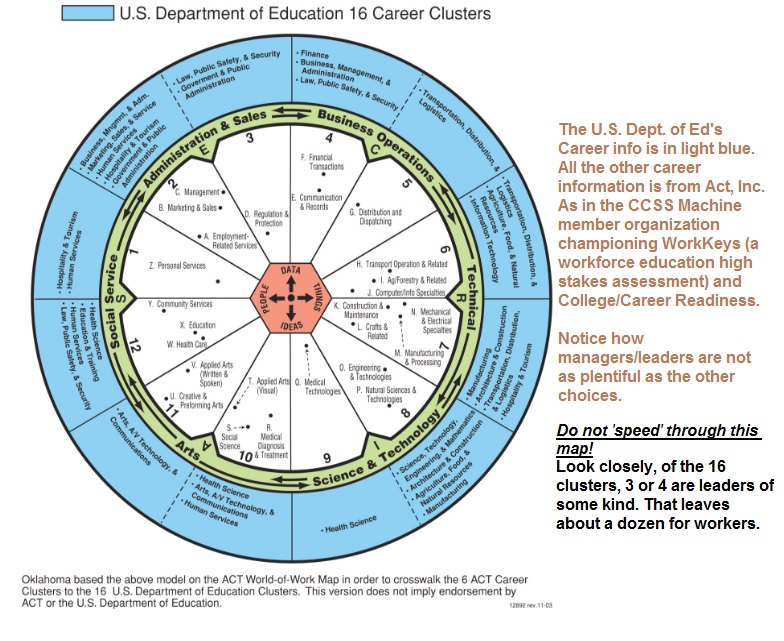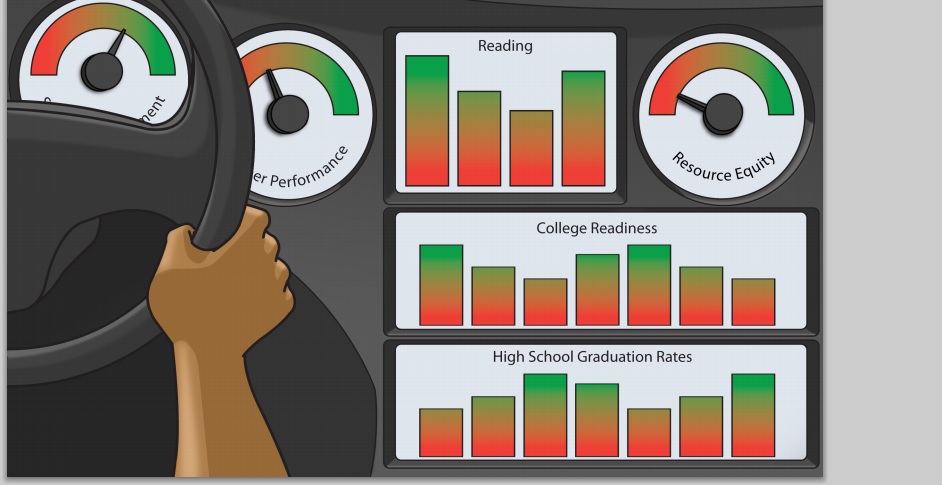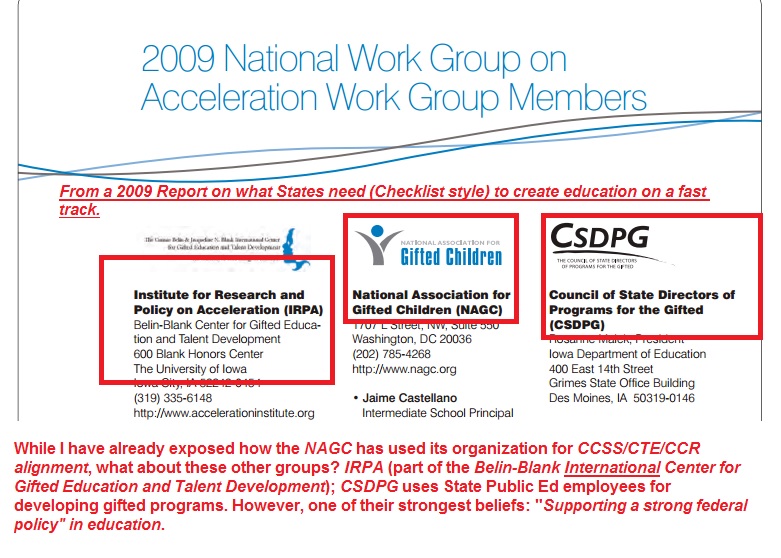Warriors, my anti CCSS/ESSA Weekend News was such a revelation, wasn’t it? Thank you to all who have responded. As I promised in the ‘Closing’ of that article, I am using today’s “From the Files” post to look at the OTHER gifted/talented national organizations. Are they just as sold out and devoted to the CCSS Machine as the NAGC (National Assoc. of Gifted Children)? If you missed the NAGC article,
If you would like to only see the other national gifted groups, skip to Part Two. If you would like to see more on how gifted students and ESSA intersect, see Part One.
Part One: Speeding Up’s Agenda:
If you didn’t know it (or you missed the big bombshell news), the ESSA (Every Student Succeeds Act) has written in the ‘fine print’ how gifted and high-ability learners will be used as research subjects. We have seen how the U.S. Dept. of Ed and its partners have used other sub-groups of students for research purposes in the past. It is truly despicable! So why write into the ESSA measures to create a NEW gifted and talented research facility, a director to oversee this, AND the Sec. of Ed’s power used to control it all?! Based on research of my own into the CCSS Machine (including its agenda, legislation, etc.), I think it is a two-prong plan.
Prong #1: Separate the gifted/talented students from the students who are not. It fits right in with the leader/follower mentality we have seen surface in CCSS lessons, maneuvers for alignment to a workforce based education system, AND in the Career Clusters of the CCSS Machine. How? Look at the small number of Clustered Tracks for Career in Management/Leadership and compare it to the larger Clustered Tracks for workers.
What you see below is a map from the U.S. Dept. of Education for the Career Clusters (aka: Career Tracks):
 I featured this image (map only) in a previous article. It is a great resource for a back ground information set of facts. See: https://www.commoncorediva.com/2015/03/12/tech-thursday-difference-between-careers/
I featured this image (map only) in a previous article. It is a great resource for a back ground information set of facts. See: https://www.commoncorediva.com/2015/03/12/tech-thursday-difference-between-careers/
Prong #2: Control and greed. We know much of the rhetoric surrounding the ESSA is more about global workforce for a global economy than whether or not Johnny and Susie can read, write, or think for themselves. We’ve also heard enough junk about training for those mysterious 21st Century jobs with 21st Century Skills. To see my previous collection of alignment for workforce (encompasses local, state, federal, and points to global), see: https://www.commoncorediva.com/2016/05/25/aligned-workforces/
So, take those 2 Prongs, apply them to the gifted learners and what do you get? Students speeding through education. This also fits the ‘cart before the horse’ tactics the CCSS/CCR/CTE (Common Core State Standards, College and Career Readiness, Career Tech Education) uses. Teachers are being forced to introduce lessons, resources, and other materials to students who are simply not mature enough (yes, this applies to our high-ability learners, too) to handle it all. Throw in the fact that written in the ESSA is the mandate that ALL students learn (and teachers teach) to ‘Challenging State Academic Standards’ which also align with credentialed industry parameters all geared for post-secondary readiness. (On pages 32 and 33 of the ESSA Final Conference Report, you can find how States(on their local levels) must use part of the federal funds for education which fits this mandate. States MUST tie this to the WIOA, Workforce Innovation and Opportunity Act of 2014)
Here’s the excerpt, “‘‘(c) LOCAL USE OF FUNDS.—A local educational agency receiving an award under this section— ‘‘(1) may use not more than 1 percent of its award for outreach and communication to parents about available direct student services described in paragraph (3) in the local educational agency and State; ‘‘(2) may use not more than 2 percent of its award for administrative costs related to such direct student services; ‘‘(3) shall use the remainder of the award to pay the costs associated with one or more of the following direct student services—
‘‘(A) enrollment and participation in academic courses not otherwise available at a student’s school, including— ‘‘(i) advanced courses; and ‘‘(ii) career and technical education coursework that— ‘‘(I) is aligned with the challenging State academic standards; and ‘‘(II) leads to industry-recognized credentials that meet the quality criteria established by the State under section 123(a) of the Workforce Innovation and Opportunity Act (2910 U.S.C. 3102); ‘‘(B) credit recovery and academic acceleration courses that lead to a regular high school diploma; ‘‘(C) activities that assist students in successfully completing post-secondary level instruction and examinations that are accepted for credit at institutions of higher education (including Advanced Placement and International Baccalaureate courses), which may include reimbursing low-income students to cover part or all of the costs of fees for such examinations; ‘‘(D) components of a personalized learning approach, which may include high-quality academic tutoring..”

Part Two: National Gifted Groups and the CCSS Machine/Global Education:
The Acceleration Institute:
Website: http://www.accelerationinstitute.org/Default.aspx
According to their website, each State has some level of policies already in place for those needing ‘accelerated’ education. So, who or what is the Accelerated Institute? “The Acceleration Institute was first established under the name, “Institute for Research and Policy on Acceleration” in 2006″. It is housed at the University of Iowa. From 2006-2012, the John Templeton Foundation was the financial supporter. While I have not been able to see what groups have supported the Institute since then, I can tell you there is much support for it via the University of Iowa’s College of Education, and partner programs like the one it has with Steston University. (see: http://www.stetson.edu/other/hats/).
Part of their work is to shape State policies in education. Here is a screen shot from their 2009 partnership created document expressly for the States to use as a checklist for the appropriate ways to create/implement gifted and talented programs.
 To access the either long or short 2009 Checklists:
To access the either long or short 2009 Checklists:
http://www.accelerationinstitute.org/Resources/Policy_Guidelines/
*(Note: the access the other 2 partner groups: a) IRSP:
http://www.ctd.northwestern.edu/institute-research-and-policy-acceleration-irpa
b) CSDPG: http://csdpg.weebly.com/ )
To see a more up-to-date resource for Accelerate Institute and your State: http://www.accelerationinstitute.org/Resources/Policy/By_State/Default.aspx
What kinds of education are considered for being ‘sped up and finished early’? Early entrance to preschool, early entrance to kindergarten, scoring well enough you can skip grades, early college programs (includes dual enrollment), and early graduation. Factor in that EVERY type of educational choice can utilize these programs and suddenly, EVERY student is capable of being sped up somehow. Warriors, why the rush for our young people? But wait, the Accelerate Inst. folks also have a STEM (Science, Technology, Engineering, and Math) ‘Speeding Course’. (Look at the Career Cluster map, above, again find the STEM jobs. They ARE part of the CCSS Machine. They are a big part of personalized learning, too.STEM is also embedded in the ESSA.)
Warriors, it is important to note that Act, Inc. is also based in Iowa. We know that the Gates Foundation has given many grants to the Act, Inc. folks. Coincidence in the locations of the Accelerated Institute AND Act, Inc.?
The U.S. State Department’s Gifted Program:
Website: http://www.state.gov/m/dghr/flo/c21956.htm
Here is an excerpt from their website, “Within the cross-section of learning styles are children who display an extraordinary intellect or passion for learning. Gifted children do have special educational and social/emotional characteristics, and the responsibility for educational planning falls upon the individual family. Parents need to become advocates for their gifted children by ensuring that each child’s particular needs are met throughout his or her educational career. The personality and interests of each child should be weighed along with the intellectual or artistic potential.” The State Dept. is addressing their employees in this. Not the general population. However, look at the State Dept’s allowance for Gifted Education participation. It includes public education, private schools, at home study. It encompasses the same College Board, AP, and IB courses!
https://aoprals.state.gov/content.asp?content_id=249&menu_id=81
If you look at the main U.S. State Dept. website above, scroll down to near the bottom of the page to see the resources. The same CCSS Machine sources. Be sure to note the Youth and Education Programs the State Dept. has. Note how global some of them are. The U.S. State Dept. also has its hand in higher education from a global aspect. See: https://educationusa.state.gov/
Oh, and Warriors, one last fact: The U.S. State Dept. uses some of the same data mining education/workforce information as the U.S. Dept. of Ed and the U.S. Dept. of Labor. See:
http://www.state.gov/r/pa/map/index.htm
National Society for the Gifted and Talented (NSGT):
Website: http://www.nsgt.org/
For our final look at a national organization for ‘high-ability learners’, the NSGT, is also sold out to the CCSS Machine. I will get to that in a moment. However, what does the organization do? “The National Society for the Gifted & Talented (NSGT) is a not-for-profit 501(c)(3) organization created to honor and nurture gifted and talented (G&T) children and youth. It is committed to acknowledging and supporting the needs of G&T children and youth by providing recognition of their significant academic and performance accomplishments and access to educational resources and advanced learning opportunities directly related to their interests and talent areas.” How do they do all this? P3s (public private partnerships)! “NSGT collaborates closely with other G&T program providers, school districts, colleges and universities, community programs, and corporations, and we invite all stakeholders who are dedicated to fostering the development of these extraordinary young people..” What ages does the NSGT target? 5 years old to t 17 years old.
As far as how sold out to the CCSS Machine NSGT is, consider a former sponsor is none other than ETS (Educational Testing Service) which has been aligning assessments to the CCSS/CCR/CTE education reform for awhile. Some States have even abandoned SBAC and PARCC assessments to use ETS’s assessments. It’s a lateral move, Warriors!
The NSGT also cites a global gifted education program housed in the University of Warwick (UK). One of the main benefits?! Global education/culture exchange. See below:

While this seems innocent enough, the University of Warwick is a UNESCO partner institution. See: http://www.unesco.org/most/partners.htm (look for ‘CRER’)
If you missed it a few days ago, I dug into global education with the CCSS Machine’s and UNESCO’s involvement via the upcoming Olympic Games. See: https://www.commoncorediva.com/2016/07/13/going-for-the-golden-games/
Closing:
Again, Warriors, we are seeing the same pattern. US law (ESSA) used to support global goals. Consider, we started with gifted learners and have circled back to how it all connects to UNESCO. Between the two gifted articles, you see how in-depth the scourge is going. There is no quick read. We must get in the cracks and crevices of the CCSS Machine to know all we can to protect our nation. Thank you for bearing with me through the twists and turns of this information.


2 thoughts on “Speeding Through Education, Pts. 1/2”